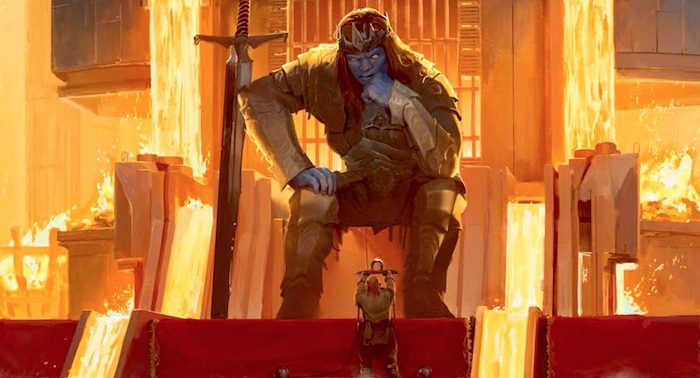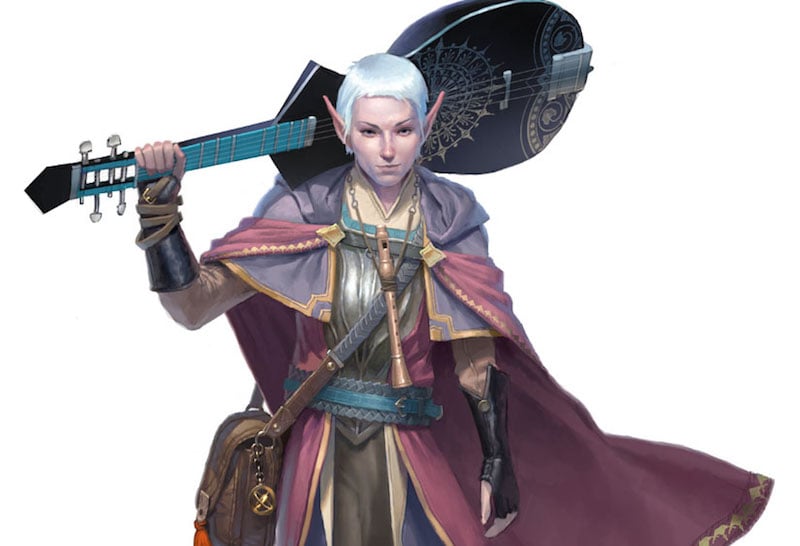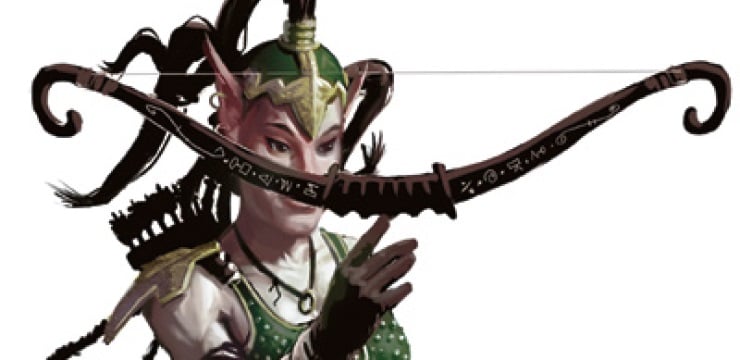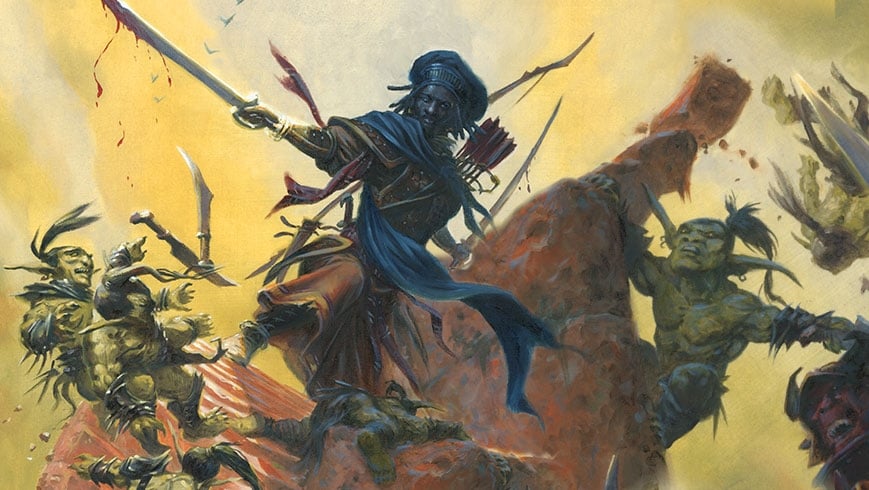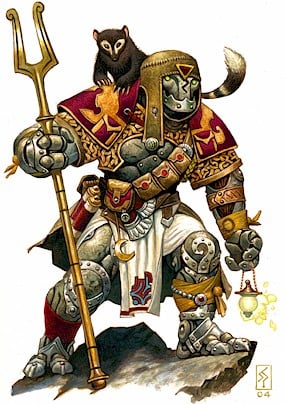Unearthed Arcana: Revised Archetypes

Unearthed Arcana is back to monthly now, but here’s five revised archetypes to keep you busy.
The transition from Weeklly to Monthly Unearthed Arcanas will doubtless be difficult–but to help ease the transition, Wizards has released five revised class archetypes–one each for Bards, Barbarians, Fighters, Monks, and Sorcerers–which gives us a look at the direction these classes are headed in before their upcoming release. Clearly they are listening to the feedback they’ve been getting, so if you want to see how your own thoughts/experiences can potentially shape the game, take a look at these new versions of old updates.
There are four this time around:
Ancestral Guardian – A Barbarian archetype focused on protecting your allies and punishing foes who dare your wrath.
College of Swords – A Bard archetype that is all about dazzling your foes with fancy flourishes (and also you’re still a Bard so you can do whatever else you want, really).
Arcane Archer – A Fighter archetype that takes your archery and arcanes it up with extra effects–meaning you can basically be like the Green Arrow.
Kensei – A Monk archetype that makes a weapon an extension of your body, allowing you to channel your ki in new and devastating ways.
Favored Soul – A Sorcerer archetype, blessed by the gods, with access to Divine Spells and metamagic.
The revisions run from Subtle to Substantial, so we’ll be taking a look at what’s changed to better get an idea of where the game is heading as we ramp up to the next big release.
Ancestral Guardian
First of all, here’s the previous iteration of the Ancestral Guardian. Now, let’s dive in to what’s different about this latest version.
This one has had a fairly substantial overhaul. Many abilities have been reworked to make the guardian much more of a defender type. Ancestral Protectors now no longer requires a bonus action to designate a target, instead it’s the first creature you hit with a melee attack each round. It still “marks” them, giving them disadvantage on attacks against foes that aren’t you. But now it also gives creatures that aren’t you resistance to the marked creature’s attacks. Meaning you can really grab the attention of a monster if you want–this combos nicely with the Barbarians enhanced mobility. I can see doing a spring attack style maneuver on a hard-hitting creature like an assassin or a bugbear that’s going after your squishier members.
Ancestral Shield becomes Spirit Shield and now instead of letting you shift your rage granted resistance to creature, it lets you use your reaction to flat out negate 2d8 damage to another creature, gaining more dice as you level up. I really like this change, it’s a lot more active, and granted you can only do it while raging, but it really fits more with the flavor of the class.
Consult the Spirits now actually feels like an ability worth gaining at 10th level. Before you could use it three times per rest to gain advantage on a Wisdom or Intelligence check–which is nice, don’t get me wrong, but that hardly feels comparable to things like an at-will fear effect, or casting commune with nature. But now you can just use it to function like clairvoyance. Which still feels a little wonky to me, but is at least an interesting use of the ancestral spirits at your command.
Vengeful Spirits changes from a conditional 2d8 extra damage to be an upgrade for Spirit Shield. Whenever you use Spirit Shield, you also deal that same amount of damage to the enemy. And for those of you playing along at home, this is 4d8 damage both negated and protected at once (before you had to choose whether to protect or damage).This feels about right for a 14th level power. I really like this change–it makes your reaction much more meaningful–and it gives Barbarians who take this path a vested interest in the flow of the whole fight.
College of Blades
As before, here’s the previous iteration of the College of Blades, for your enjoyment.
This too has had a fairly substantial rework. Its abilities have fallen firmly on the melee side of things–no more knife throwing flourishes, but it’s a little more flexible in its melee option. You now have a choice between Dueling and Two-Weapon Fighting when you select your fighting style. Additionally your weapon is now explicitly a focus for your spellcasting (which I assume they had intended before but just left off).
Blade Flourish is the signature feature of the class. Spend your Inspiration and make an attack that does something cool. Also you gain ten feet of movement just for flourishing, so you can extend your attack range just that much further in a single turn. The individual flourish options have been reworked significantly, with the exception of Defensive Flourish which is exactly the same (add your bardic inspiration die roll to your AC). Now instead of the Trick Shooter’s Flourish, there’s Slashing Flourish which lets you deal your bardic inspiration as damage to each creature of your choice near the target. Unnerving Flourish is replaced with Mobile Flourish, granting you a push and follow ability to the attack. And while this definitely fits the archetype, I do miss the ability to intimidate your opponent into revealing everything if you spare their life when you could have killed them.
There’s a minor change to Extra Attack, it’s replaced with Cunning Flourish, which is basically the same thing, except you can only do it while flourishing.
And finally Masterful Flourish replaces Battle Magic, which let’s be honest, is more the purview of things like the Eldritch Knight or the Bladesinger. And besides, getting to roll a d6 instead of spending one of your bardic inspiration dice means that you will always be able to flourish, while also still being a bard. So again, you’ll be able to do whatever else you want.
Arcane Archer
As it was before, so shall it be again.
This is one of the more subtle revisions. A few fundamental things changed, which necessitated a change to the powers that were informed by it–so it might look like a lot, but basically the big thing that happened here is the way they changed Arcane Shot and Create Magic Arrow. They basically folded those two abilities together into a revised Arcane Shot that all now do increased damage (effectively they all do the 2d6 damage that Create Magic Arrow did, but now they do that with an extra effect applied). There is one big thing though. Now they get Magic Arrow which is the old Arcane Archer favorite: all arrows count as magical and grant +1 to hit and damage. I don’t think this is a good move, all in all, it’s real powerful and it’s a 3rd level ability. You’re already getting an extra +2 to hit because you picked up the Archery fighting style. This just feels boring and unbalanced.
Two other things worth noting:
The lackluster Conjure Arrows (useful when you’re out of arrows, but also not that useful in the long run) is gone, replaced with Curving Arrow which lets you use a bonus action to redirect a missed attack with a magic arrow to a different target within 60 feet of the original one.
And at 18th level, all damage affiliated with your Arcane Shot gets upgraded to 4d6.
Kensei
Here’s the earlier version. Let’s get crackin’.
The biggest change here is that Kensei no longer get three weapons, but two–specifically one melee and one ranged. And the rest of their rework revolves around supporting either option as fully as they can. This means things like the ability to use Dex or Strength on a Kensei weapon, as well as the ability to deal your martial arts die instead of weapon die are gone–the weapon you pick is important. You can still spend a bonus action to deal 1d4 damage to each creature you’ve hit with an attack, only now it only applies to ranged attacks.
The only other big differences are the way Precise Strike has changed. Now instead of making sure you hit–it lets you spend a ki point to add your martial arts die to your damage roll as bonus damage when you hit with a kensei weapons.
Similarly, the archetype’s ultimate ability, Unerring Accuracy only applies when you’re using a monk weapon (presumably your Kensei weapon). In general these ones feel more like the sorts of things that’d get fixed in errata, which means Wizards must think the class is in a pretty good place.
Favored Soul
Here’s the source(erer) material.
Another subtle revision. The class feels like it’s about where it’ll end up–though they do seem to have given it just a little reprioritization in terms of what its abilities do. Favored Souls are much more Healer types now. As part of their Divine Magic feature, they gain cure wounds as a spell that doesn’t count against sorcerer spells known. And their 6th level ability changes from Divine Countenance which used to make them all pretty, to Empowered Healing which lets them reroll underperforming dice on healing spells for the cost of a sorcery point.
Don’t worry, you can still be otherworldly beautiful/youthful/angelic as a Favored Soul, though. That ability just gets folded into the 14th level ability Angelic Purity which grants you a pair of wings, a fly speed of 30 ft, and a youthful/beautiful/angelic/imposing countenance (pick one). They’re spectral as well, for added coolness.
And there you have it. It seems like there’s a more uniform consensus that special things should do around 4dX in the upper levels, and that healing needs a little bit of a boost in power. It’ll be neat to take a look at how some of the other classes change as we get nearer to the release date of all of these. Whenever that is.
Check out the Full Article
Take the Feats for Races Survey
Still waiting for them to update Jester kit. One day. One day…


